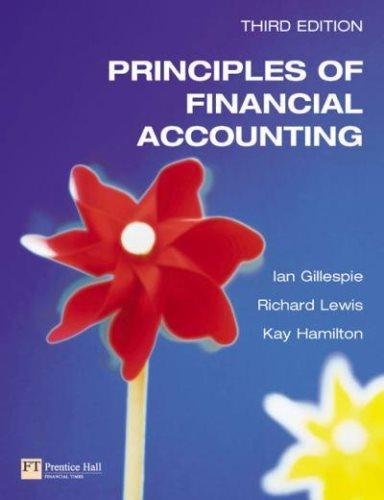2.7 Clive started business as a seller of automatic cameras on day 1 by transferring 50,000 from...
Question:
2.7 Clive started business as a seller of automatic cameras on day 1 by transferring £50,000 from his private bank account to a newly opened business bank account.
From the start he employed an assistant, Steve. Clive agreed to pay him £30 per day, the payments being made every three days, i.e. days 3, 6, 9, etc.
Clive’s other transactions for the period day 1 to day 10 were as follows:
1.
2.
3.
4.
5.
6.
7.
8.
9.
10.
11.
12.
13.
14.
15.
Day 1 Acquired, for cash, the lease of a shop for £20,000.
Day 1 Acquired, on credit from XP Limited, fixtures and fittings for the shop, amounting to £10,000.
Day 1 Acquired, on credit from SA Limited, 50 automatic cameras at £80 each.
Day 1 Acquired, for cash, 12 cameras at £70 each. Clive also paid £120 for the carriage of these goods to his shop.
Day 2 Sold, on credit to CA, 4 cameras for £120 each.
Day 3 Sold, on credit to CB, 6 cameras for £120 each.
Day 3 Purchased, on credit from SB Limited, 10 cameras at £100 each.
Day 4 Clive agreed that two of the cameras sold to CA were defective and they were returned to him. One of them was repaired by Steve. This required the purchase (for cash) of sundry materials of £20. The repaired camera was retained in stock. The other camera was returned to the original supplier, SA Limited.
Day 5 Sold, for cash, 10 cameras for £140 each.
Day 6 Sold, on credit to CC, 20 cameras. The selling price was £140 each but as CC is Clive s wife’s cousin, Clive agreed that CC could have a discount of 10 per cent.
Day 7 Received £500 from CB on account.
Day 7 Received from CA the total amount due from him.
Day 9 Sold, for cash, 4 cameras at £150 each.
Day 10 Clive withdrew £200 for his own use.
Day 10 Paid XP Limited £5,000 and SB Limited the whole amount due.
Clive’s sundry expenses, which are outstanding at the end of day 10, are £50 per day.
Assume that the cameras are sold in the order in which they were acquired. (This is known as the ‘first in first out’ method.)
Required:
(a) Complete the analysis sheet (as used in Figure 2.3 in the text), recording the above transactions.
(b) Piepare Clive s balance sheet as at day 10 and his profit and loss account for the period day 1 to day 10.
Step by Step Answer:

Principles Of Financial Accounting
ISBN: 9780273676300
3rd Edition
Authors: Ian Gillespie, Richard Lewis, Kay Hamilton





